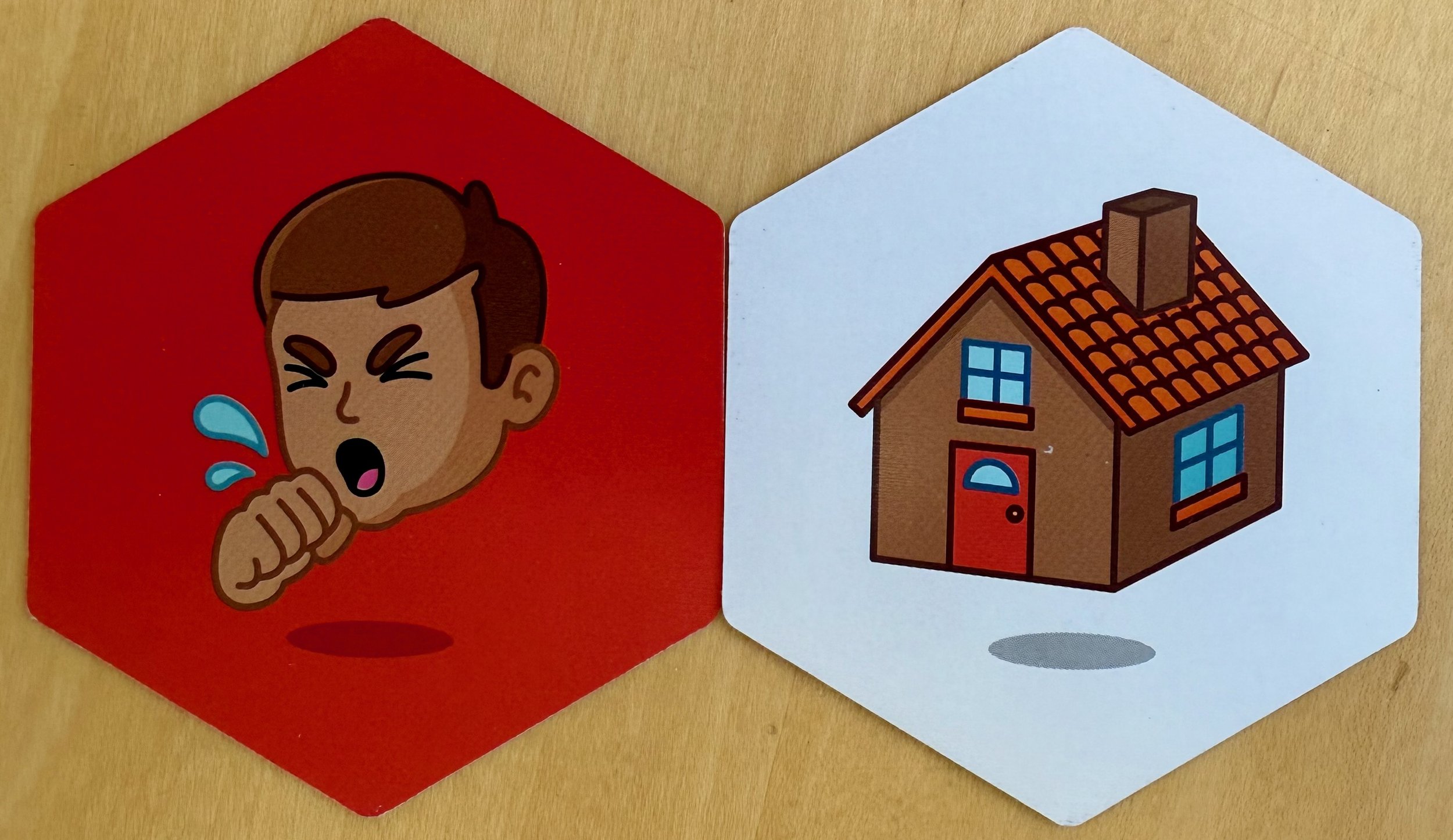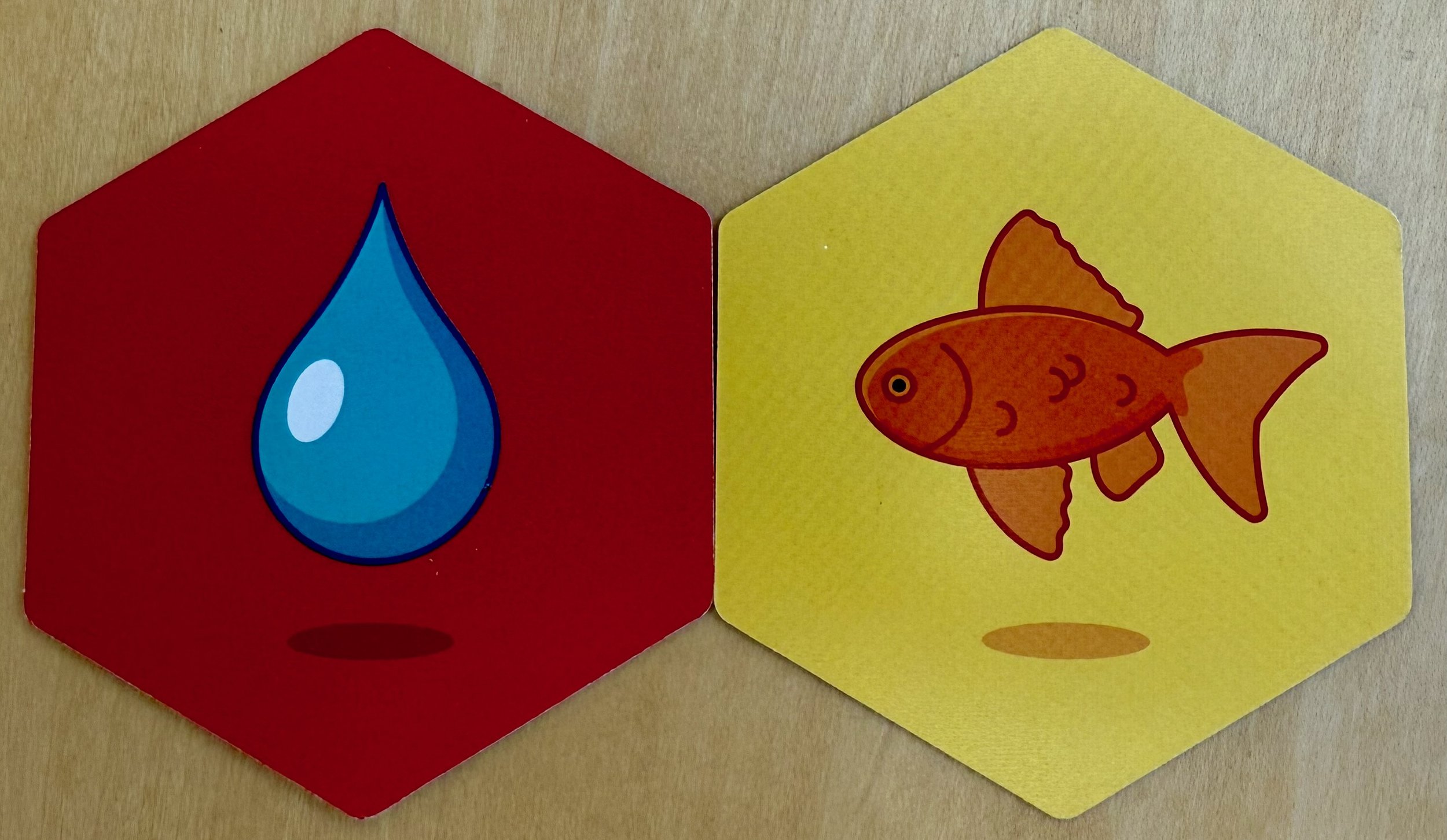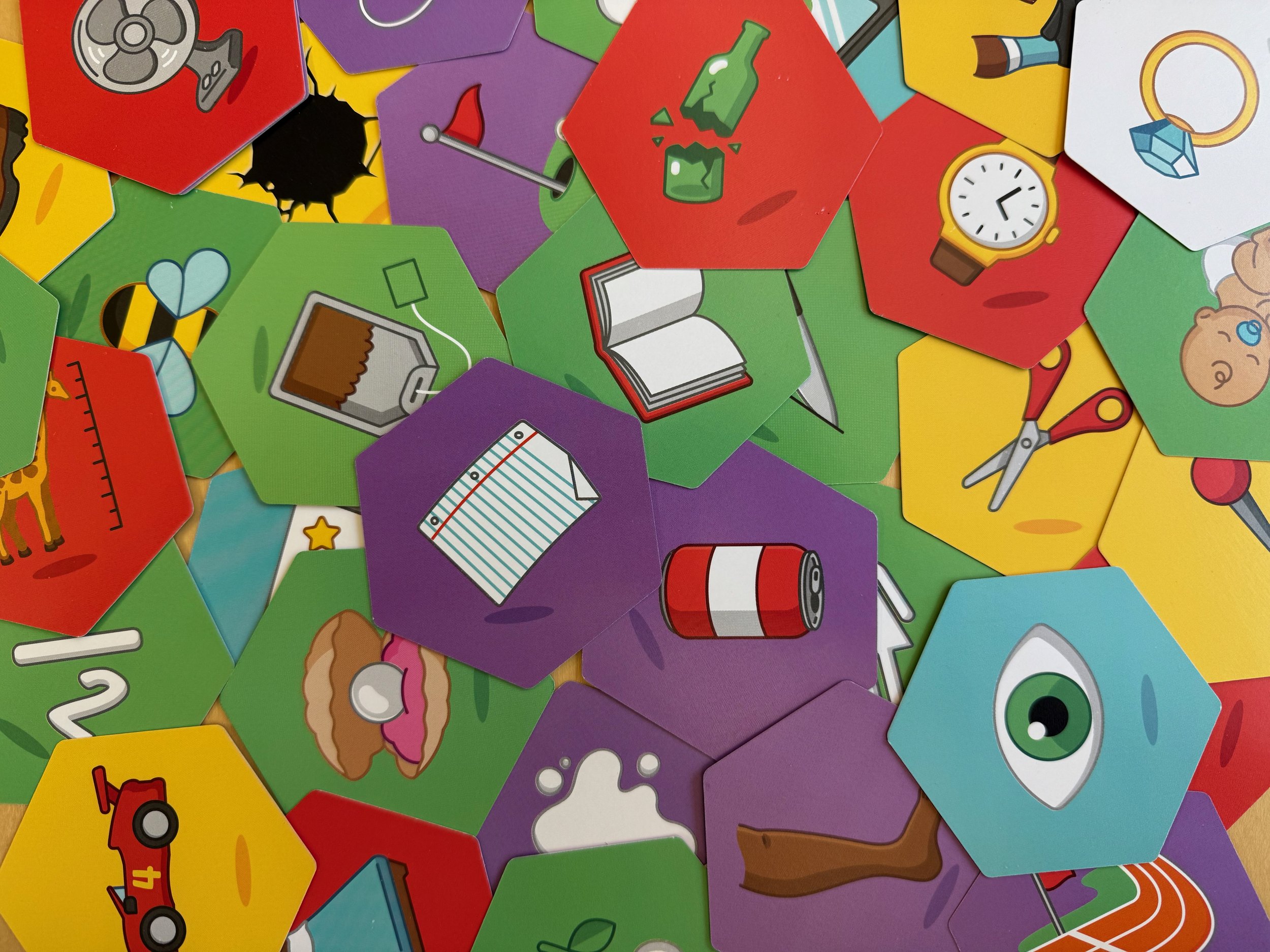Turn a Phrase, Twist of Thought: A Game That Messes With Your Head (In a Good Way)
The first time you play Turn a Phrase, you might think, Oh, this is cute. You slap down a few hexagonal cards, link them together based on wordplay or cultural references, and pat yourself on the back for being clever. Maybe you create a sequence like "coughy (coffee) house" or "fish out of water" and feel satisfied in the way one does after correctly using a word like zeitgeist in casual conversation.


Think of this game as a more formalized mashup of Chris Cavert’s Word Circles and Picture Word Circle Cards. Out of the box, the game offers an interesting challenge in making connections. It primarily functions as a light party game rather than a structured team-building exercise. But guess what? With a few tweaks, Turn a Phrase transforms from a mild-mannered parlor game into a psychological experiment where your ability to think logically is tested against the chaotic minds of your teammates. In our variation, groups arrange cards into a sequence that they think makes sense, document their reasoning, and then pass the jumbled mess to another team, who must reconstruct the original order. The catch? There is no universal logic, just the scattered, subjective interpretations of people who, only moments ago, were probably struggling to agree on a lunch order.
Hexagonal Thinking: Because Linear Thinking Is Overrated
Even before we tinkered with the rules, Turn a Phrase already aligned with hexagonal thinking, a popular education strategy that encourages people to make flexible, creative connections between ideas. Unlike traditional concept mapping, where thoughts move predictably from one to the next, hexagonal thinking assumes that the human brain is more like a cluttered kitchen junk drawer where everything connects, but in ways that don’t always make immediate sense.
This approach gained traction thanks to educator Betsy Potash, who championed it as a tool to get students to make unexpected connections. The appeal is that there’s no single right answer, just an evolving web of meaning negotiated through discussion. That’s why this variation of Turn a Phrase is so compelling. Teams aren’t just solving a puzzle; they’re wrestling with the fact that their logic is not, in fact, universal.
The Team Challenge: Or, How to Find Out Your Friends Are Not As Logical As You Thought
The modified game begins innocently enough. Each team gets eight cards and arranges them in what they believe to be a logical sequence. Do you lean on pop culture references? Pure wordplay? A deeply personal connection no one else could possibly understand? The beauty of this stage is that it feels deceptively easy. You create your sequence, jot down your reasoning, take a photo, and, like an overconfident contestant on The Great British Bake Off, assume everything will go smoothly.
But then comes the real fun. After shuffling all but the first card and last card in your sequence, you pass your scrambled lineup to another team, who must now attempt to reverse-engineer your brain based on nothing but the starting and ending clues (make it even harder by only giving the first or last, not both). This is where reality sets in. Suddenly, your foolproof logic is subjected to the whims of strangers who, bafflingly, believe that images of a “water drop” and a “fish” belong together in a way that has nothing to do with your brilliant “fish out of water” idea. You watch, helpless, as they confidently place your carefully curated sequence into what can only be described as a crime against reason.
When the original team returns to review the reconstruction, the discussion that follows is both hilarious and slightly existential. Were your connections too obscure? Were theirs too literal? Does anyone actually think the way you do? And if not, what does that mean for the hundreds of assumptions you make in everyday life?
At this point, as the facilitator, it’s time to sit down and talk about what just happened and sort through the logical wreckage, pinpoint where things went off the rails, and try to understand how, despite everyone’s best efforts, your beautifully constructed sequence now looks like a conspiracy board put together by someone who hasn’t slept in three days. To guide this process, consider focusing on some key skills conversations:
Pattern Recognition and Logic (Or, Why Is This So Hard for Other People?)
So, what was your team’s plan when you arranged your cards? Were you going for obvious connections, or did you overestimate the group’s ability to decipher your highly sophisticated sense of humor?
Were there any connections that you all thought were painfully obvious, only to discover that no one else had any idea what you were getting at? At what point did you start questioning your own intelligence?
Did your team rely more on pop culture, general knowledge, or obscure personal references that, in hindsight, only made sense to one of you? Did anyone on your team fight for a connection so specific that the only way to understand it was to have lived in their childhood home?
Now that you've seen how wildly things can go wrong, if you could redo your sequence, what would you change?
Communication and Explanation (A.K.A. How to Make Other People Understand You Without Losing Your Mind)
When your team wrote down your reasoning, did you all agree on the best way to explain your logic, or was it more of a we’ll figure it out later situation?
What part of this process was the most difficult: actually making the connections, explaining them, or accepting the fact that the other team ignored everything you wrote and made their own storyline anyway?
When you saw the other team’s reconstruction, did it confirm that your explanation was clear, or did it make you question your ability to communicate even the most basic of ideas?
Now, zoom out for a moment…how often does this kind of misunderstanding happen in real life? What’s one time you confidently explained something, only to realize the other person had no idea what you were talking about? (And no, every work email you’ve ever written is not an acceptable answer.)
Perspective-Taking and Interpretation (Or, Why People Will Never See the World the Way You Do)
When you saw the other team’s reconstruction, what was your first reaction? Were you shocked, amused, or did you immediately suspect sabotage?
Did you find yourself begrudgingly admitting that, while wrong, their connections kind of made sense? What does that say about the fact that meaning isn’t fixed, but shaped by experience? (Or, more importantly, does it mean your original sequence wasn’t as brilliant as you thought?)
How did your team react when your logic wasn’t followed? Were you flexible, or did someone immediately go on the defensive, insisting that their connections were obviously the correct ones?
Now, take this concept out of the game…how does this activity remind you of the way people interpret and process information in daily life? Think about misread text messages, family arguments over completely different versions of the same event, or that time you gave someone directions only to watch them confidently walk in the opposite direction.
Why This Is an Unintended Therapy Session
What makes this game so effective is that it reflects real-life collaboration, except with fewer passive-aggressive emails. In most professional and educational settings, teams are constantly working with incomplete information, trying to reconstruct meaning from partial clues. A manager sends out a vague memo, a teacher assigns a group project, a friend texts you "K"—and suddenly, you’re stuck trying to decipher intent with nothing but context and past experiences to guide you.
This game forces you to confront how wildly different people’s thought processes are, which is both a fun intellectual exercise and a minor crisis of identity. You start to see communication not as a simple transmission of facts but as a negotiation of meaning and one that often requires more patience and clarification than you realize.
How to Fail, Reflect, and Try Again Until You Pretend You Knew What You Were Doing All Along
If you’ve ever thought, Wow, I really learned a lot from that thing I just completely screwed up; congratulations - you’ve participated in experiential learning! David Kolb mapped out this process in a neat little four-step cycle, which, when applied to this game, basically explains why you went from confident genius to self-doubt to begrudging acceptance all in the span of 15 minutes. Let’s take a quick peek at the cycle:
Concrete Experience: This is the part where you and your team enthusiastically arrange your image cards, convinced you are creating something both brilliant and foolproof. You take a step back, admire your work, and maybe even give each other a smug little nod. “We crushed this,” someone says. Oh, how innocent you were.
Reflective Observation: The first moment of doubt creeps in. You’ve shuffled your cards and handed them off, and now, watching another team struggle to reconstruct your sequence, you start to see the cracks in your logic. Why did you assume everyone would understand your very specific reference to that one scene from a 90s sitcom? Did you actually explain anything, or did you just assume people would get it?
Abstract Conceptualization: This is when your brain does mental gymnastics to explain what just happened. You look at how the other team misread your connections entirely, and instead of screaming, “How could you not see that?!” you try to analyze why they didn’t. Was your logic too obscure? Were your instructions unclear? Do people just have fundamentally different ways of making sense of the world? (Spoiler: Yes.)
Active Experimentation: Armed with this newfound awareness, you adjust your approach. Maybe you simplify your connections, or perhaps you overcorrect and spell everything out to the point where it feels like you’re explaining a joke. Either way, you’ve learned something, and whether you admit it or not, you’re kind of excited to try again.
And just like that, we are right back where we started - but yet different. You have experienced, failed, overanalyzed, and tried again, which, if you think about it, is pretty much how all of life works.
Vygotsky Would Have Loved This
If Kolb’s cycle explains why you learned something, Lev Vygotsky’s social constructivist theory explains why you had to stumble through it with other people. Knowledge isn’t built in isolation because it happens through interaction. In this game, as teams justify their reasoning, they are essentially negotiating meaning, which sounds very intellectual but is mostly just people arguing over whether a connection makes sense or not. Watching another team completely misinterpret your sequence forces you to see language and meaning as fluid, which is a fancy way of saying, Maybe I am not the center of the universe, and other people think differently than I do. The beauty of this is that it forces players to communicate more clearly, consider alternative viewpoints, and - if nothing else - accept that human communication can be an absolute mess and that we’re all just doing our best.
In the end, this game isn’t just about phrases and wordplay. It’s about trial and error, social negotiation, and coming to terms with the fact that no one will ever understand you the way you assume they should. If you ask Kolb or Vygotsky, that is exactly the point.
What People Will Walk Away With (Besides a Healthy Dose of Self-Doubt)
Aside from the fact that your brain is weird, and so is everyone else’s, this challenge sharpens key skills in communication, problem-solving, and adaptability. Simply, clarity in explanation becomes crucial. If your justifications were murky, your sequence probably came back looking like an upside-down avant-garde art piece. Flexibility in thinking is tested as you realize that the other team’s incorrect interpretation was, in a way, (more than) kind of valid. Collaborative problem-solving is at the heart of it all, as teams negotiate their reasoning and attempt to reach consensus.
But perhaps the biggest takeaway is that people don’t think alike, and that’s a good thing. This game proves that meaning is fluid, shaped through dialogue, and often hilariously subjective. In a classroom, this translates to more open-ended discussions. In a workplace, it means clearer communication. In daily life, it’s a reminder to ask, "What did you mean by that?" instead of assuming everyone sees the world as you do.
So, the next time someone tells you something "should be obvious," just remember this game. Then, challenge them to play. You might not win, but you’ll definitely walk away entertained and maybe, just maybe, a little more aware of how delightfully strange the human mind really is.
